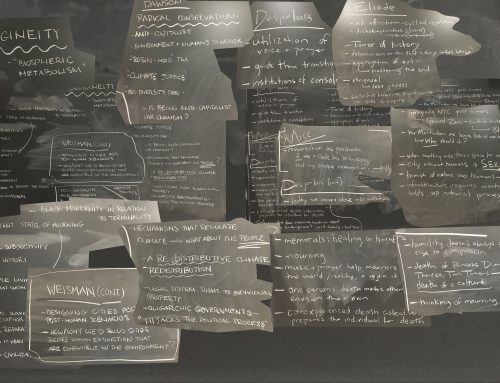Our first question that we asked Eric was concerning the social sciences. We asked what role the social sciences should have in surviving and preventing existential risks of destruction. Are we doing enough right now? What could be different? What Eric said was that we should be publishing more studies and publicizing more studies about potential existential threats that are often overlooked (such as nanotechnology and biological warfare). He brought up the Y2K bug and how it was publicized and millions of people worked to solve the problem. However, not everyone, including the extremely wealthy, are aware of the threats like backyard virus manufacturing. In order for money to go to solving issues and preventing future problems, current existential risks must be understood and articulated to the population in a way that is factual without downplaying the severity or fear-mongering the issue. While Eric didn’t specify any particular work amongst the social sciences that stood out to him, it is obvious that the Lifeboat Foundation is in need of more academics, thinkers, and founders to bring their ideas to fruition and to possibly save humanity from any of the numerous existential threats that we face.
On the topic of possible preparation for existential threats and disaster, Eric emphasized how different new threats created by Intelligence are different than preparing for an earthquake, or natural fires. Because those threats have happened for years and have a tendency to repeat themselves as patterns, a government can take measures in advance and create infrastructure that can mild such incidents. Instead, when disaster emerges from AI, there is no opportunity to learn from errors since there is no precedent. He also pointed out that as history shows, we live in a universe where no civilizations have survived exterior threats, so we must pay more attention. This universe has no long term survivors, and so the research devoted to this topic should be much larger than it currently is. In regards to global warming and how to solve the problematic, Eric suggested that there are already available solutions but people do not take the problem so seriously as to apply them. He thinks, the evidence is out there but It will take a more immediate threat to get people to take action.
It seems to be that Eric’s primary goal in his Lifeboat initiative is to identify the most immediate dangers facing humanity, and to raise awareness amongst academic, art, and research communities in order to create innovative solutions to problems that will impact our collective future. He lists nanotechnology, bioengineered weapons, cybercrime and cyberterrorism, climate change, artificial intelligence, asteroid/comet impact, and astrobiology, and a few others to be looming threats to life itself, and more specifically human life.
There are representations of all of these doomsday devices in science fiction (e.g. The Andromeda Strain, The Matrix, Black Mirror, etc.) which make their descriptions all the more frightening, as there are artistic interpretations to fall back on for visual representation, however romanticized. Though fictionalized, these narratives are plausible, and it is necessary to keep an open mind to the possibilities of these possible end-of-time scenarios, and utopian salvation type scenarios, without falling victim to the pitfalls of conspiracy. With the accreditation of hundreds of doctors and experts on boards focused on such widely varying fields as astrobiology, counterterrorism, ethics, finance, philosophy, arts and culture, etc., it is hard to turn a blind eye to what feels like an authentic movement towards a more unified and responsible interdisciplinary community.
We then asked Eric about who would be going to live in proposed space habitats? He said that people would have to pay to fund and potentially use the service. Additionally, people could win lottery slots and the website itself says that people could enter “lifeboat scholarships”.“All Lifeboat members are eligible for 5% discounts on Space Adventures terrestrial tours, zero-gravity and supersonic jet flights, sub-orbital space flights, and a $200,000 discount on trips to the International Space Station!” (https://lifeboat.com/ex/faq#iss) However, it was obvious that this service would be utilized only by those who can afford it. One of the things that Daryl noticed was that there were many issues within this idea of paying to escape eradication. When asked about how people would be going up to the moon or space, he made it sound like he has not really thought about people other than the ones who would pay to take a lifeboat. He either has not considered who will eventually live, or he believes that only the “best” and most “capable” people will get this opportunity. This brought up issues of exclusion, accessibility, and able-bodiedness. It is not that he necessarily was saying that he wished to be exclusionary, but that these issues have enormous social implications and realities. This could potentially be dangerous. How do we articulate differences amongst individuals and amongst society while approaching end of time scenarios? It is scary to think about a future where people like ourselves would not even be able to afford an escape from the end of times. This idea of the lifeboat to space seems to encompass all of our group’s existential fears into one fear. Whether we leave the world, we die on it, or we fund our own escape, the escape to space captures these possibilities.
